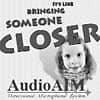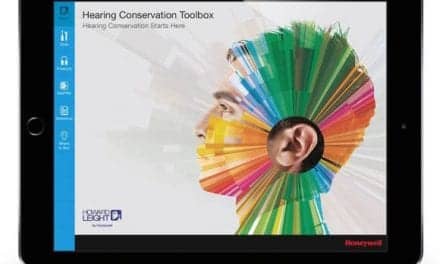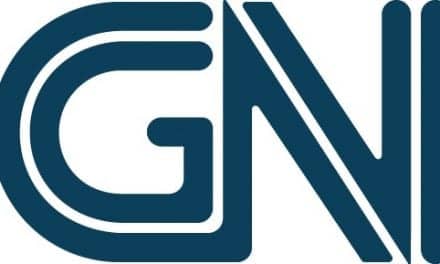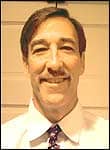In 1997, when the House Ear Institute (HEI) began offering hearing screenings and hearing conservation education to the audio and music industries, the reception was not very enthusiastic—very different from what it is today. At that time, when we asked people in the audio world if they were concerned about protecting themselves from noise-induced hearing loss (NIHL), many of them were hesitant to even acknowledge the issue, let alone do something about it. Many simply didn’t know enough about the exposure limits and the risks.
As a consequence, there now exists a whole generation of musicians and sound professionals, many of them in their 40s and 50s, who are living the rest of their lives with debilitating hearing loss, affecting their ability to communicate. The following is a summary of results and findings from HEI’s involvement in the audio industry and its comprehensive Sound Partners program (see sidebar, p 35).

House Ear Institute (HEI) established its hearing conservation program, Sound Partners™, upon recognizing that many music and audio industry professionals are at high risk of potential hearing loss but lack practical information and guidelines that they can apply to protect their hearing on the job. This issue takes on particular importance considering a career in sound inherently involves good hearing. While the audio industry has been relatively free of the burden and restrictions imposed by regulatory government oversight from agencies such as Occupational Safety and Health Administration (OSHA), without proper education about noise-induced hearing loss, people working in the industry are vulnerable to noise-induced hearing loss. Prior to the Institute’s establishment of its Sound Partners program in 1997, no other comprehensive programs (to the authors’ knowledge) were available to educate the audio industry about what had already become a serious and pervasive problem for thousands of audio industry professionals. Since that time, the overall awareness level and receptivity to learning about the risks and prevention of noise-induced hearing loss has changed radically. Many of the audio pros who were at one time quick to dismiss the notion of hearing conservation practices in their everyday work environment are now returning on an annual basis to the HEI booth at the industry trade events to have their hearing screened. Additionally, many audio professionals who have benefited from the program advocate on behalf of hearing conservation education. Future Goals. The next step for the HEI’s hearing conservation outreach efforts is to expand its reach to the listening audience—namely teens and young adults whose listening habits place them at significant risk of noise-induced hearing loss. In January 2006, HEI will launch its new public awareness campaign as a test market using a variety of media portals to gain solid market research data before a wider national rollout is launched. In the process of launching its public awareness campaign, HEI continues to explore new educational resource tools for the audio profession and new ways for the audio industry to serve as advocates of hearing conservation education and hearing health of the listening public.
|
Understanding Vocational Noise Exposure that Isn’t Really “Noise
Use of hearing screening data to study the effects of “noise” exposure on the hearing abilities of music industry professionals and drawing conclusions from data collected with a diagnostic test like the audiogram is admittedly sticky business. The audiogram alone, while used ubiquitously among clinicians and auditory scientists, is of limited use. Noise exposure throughout the day prior to an individual’s audiogram, fatigue, tinnitus, and other factors collude to create common nuisance variables that need to be controlled in some way in order to collect meaningful data.
After 8 years of hearing screenings at various annual meetings of the Audio Engineering Society (AES), the National Sound Contractor Association (NSCA), the National Association of Music Merchandisers (NAMM), and Lighting Design International (LDI), we have found that the primary value of air conduction screenings is its utility in offering a quick, easy-to-administer test of auditory function that is directly correlated to the specific region of effected sensory cells in the cochlea. The results of these air-conduction screenings are digitally stored so an individual can track their thresholds over time. This also enables the on-site audiologist to compare the results of that day to the earliest audiogram in the database for a given individual, allowing them to spot and refer those people who require further diagnostic testing or follow-up.
While we are interested in tracking this unique vocational group’s audiograms over time, quantifying the effects of overexposure to loud sounds becomes increasingly difficult when the population in question works in environments where the sound source produces an atypical type of “noise” in comparison to how we’ve traditionally thought about noise in the past.
The noise source in these cases isn’t actually “noise” at all. Most of what we know about NIHL comes from research based on industrial noise sources, while considerably less is known about the consequences of overexposure to loud music over time.
Typical vs Atypical Noise Exposure
A review of the literature offers us some idea of atypical (non-industrial) noise exposure on the hearing abilities of many groups, including classical musicians,1,2 users of personal stereos or more modern MP3 players,3-5 children and adolescents,6,7 music teachers,8 concert attendees,9 bar and club wait staff,10-12 and disk jockeys (DJs).13
While noise exposure has been demonstrated to increase psychological14 and physiological levels of stress,15,16 in contrast, music has been shown to reduce stress levels and improve overall quality of life.17 Even short durations of loud music listening has been reported as “extremely pleasurable” and possibly addictive.18
The frequency spectrum of a noise source is thought to be well-correlated with the subsequently effected frequency regions in the cochlea. Recording and measuring acoustic data at job sites where the noise source is mechanical in nature is a fairly straightforward activity. One can reliably quantify both the sound pressure level output of a steady-state mechanical noise source or the peak levels of an impulsive noise source, as well as the resulting noise dose a worker may be exposed to over a known duration of time.
The “noise source” in the case of a professional musician or audio engineer, however, is typically speech material or music, which are both broadband with a wide dynamic range. The acoustic energy output of a pair or array of speakers, floor wedges, or in-ear monitors and the resulting exposure levels as a function of time can vary wildly across devices. Differences can also be measured according to the driver type of a speaker, listener proximity to its output, and exposure time to the sound source which itself is further complicated by the often intermittent playback of a signal.
These variables complicate matters when trying to draw conclusions about the specific contribution that on-the-job sound exposure makes towards the total amount of hearing loss acquired over time by a musician or an audio engineer. Similarly, musicians and audio engineers may also be regularly exposed to additional loud sounds on their commute to and from work or during recreational activities. Vocational history then becomes increasingly important to consider when counseling a patient who may be diagnosed with NIHL, especially when the sound source in question may be atypical in nature to what is conventionally thought of as “on-the-job noise exposure.”
NIHL in Audio Professionals: Audiometric Profiles
The authors believe that the data collected at the major professional society trade shows and presented here may represent the only audiometric database of its kind. It includes over 6500 audiograms collected exclusively from individuals who identify themselves as professional audio engineers, musicians, or related industry professionals. Analysis of the group’s audiometric results is ongoing.
For this discussion, a sample of the data collected between 1997 and 2003 will be reported. This data was initially presented at the 2004 Scientific Meeting of the American Auditory Society.19 In this sample, we analyzed data collected from four trade shows (see Table 1): The Audio Engineering Society (1997-2003), The National Sound Contractors’ Association (1997-2002), The National Association of Music Merchandisers (2002-2004), and Lighting Design International (1999).
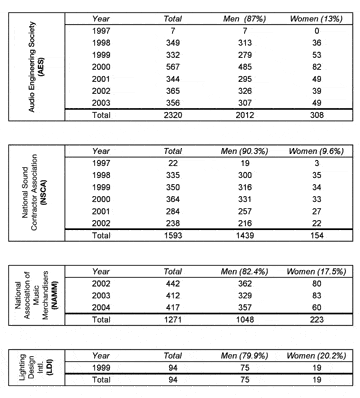
TABLE 1. Subject demographics separated by trade shows/professions.
In total, we tested 4816 attendees, the vast majority of whom were male (86.2%). A total of 5323 audiograms were collected. Of these audiograms, 16% were “serial audiograms” (ie, audiograms belonging to an attendee who participated in no more than one screening per year, but more than one screening between the years 1997-2003). A total of 350 attendees accounted for all of our serial audiograms, with men (93.7%) seeking out more repeat screening opportunities than women (6.3%). We expect that, as the educational message about hearing and hearing conservation improves, the number of serial audiogram-seekers will also increase.
While the overall number of individuals who are interested in hearing screenings at these shows increases annually, the group seeking out serial audiograms make up the core group of individuals that have taken action in response to the educational messages presented at these meetings. This group of attendees is the most likely to follow up and make an appointment when referred to an audiologist for further evaluation. Individuals in this group are also more open about using hearing protection during recreational activities, and additionally, provide hearing protection for their children as well. This is a major improvement in terms of an attitude shift seen since the screenings began in 1997.
Weighted means for right and left ear air-conduction thresholds as a function of vocation type appear in Figure 1. Further separation of data by trade show/occupation can be seen in Figure 2. An interesting observation is that, while approximately half of our population’s thresholds are within clinically “normal” limits and half are in the near-normal to mild high-frequency loss range, the configuration of the audiogram shows a surprisingly uniform notch. This suggests that, given an individual’s vocational history, near-normal thresholds or a mild hearing loss should still be cause for clinical concern; counseling about common-sense steps for hearing conservation should be a priority.
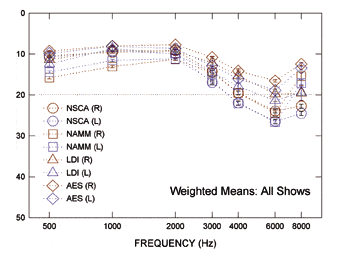
FIGURE 1. Weighted mean values of air-conduction thresholds for all attendees across the meetings shown in Table 1.
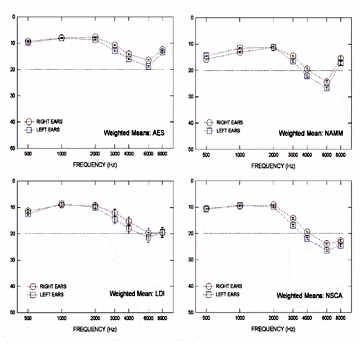
FIGURE 2. Weighted means organized by primary vocational type.
Age and Gender Effects
Ongoing data analysis (Cruz & Fisher, in preparation) relative to gender and age (decade of life) in comparison to the ISO 1999 norms reveals that, in our sample, during the earlier decades of life, men and women have similar air-conduction thresholds. However, both have poorer thresholds than their age and gender-matched peers (Figure 3).
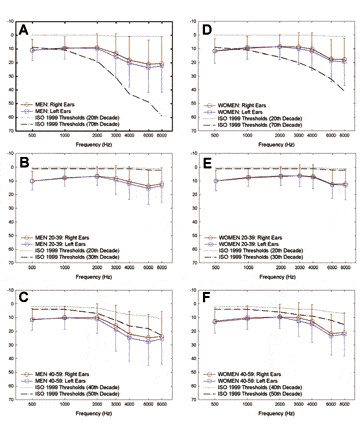
FIGURE 3. A) Male pure-tone air conduction thresholds. Error bars in all figures equal ±1 standard deviation. The dotted line represents the ISO 1999 thresholds for men in their 20th decade of life with no other known otologic abnormalities. The dashed line represents the ISO 1999 thresholds for men in their 70th decade of life with no other known otologic abnormalities. B) Male pure-tone air conduction thresholds for the 20th and 30th decades of life. The dotted and dashed lines are the ISO 1999 thresholds for men in their 20th and 30th decades of life, respectively. C) Male pure-tone air conduction thresholds for the 40th and 50th decades of life. The dotted and dashed lines are the ISO 1999 thresholds for men in their 40th and 50th decades of life, respectively. D) Female pure-tone air conduction thresholds. The dotted line represents the ISO 1999 thresholds for an average female in her 20th decade of life with no other known otologic abnormalities. The dashed line represents the ISO 1999 thresholds for women in their 70th decade of life with no other known otologic abnormalities. E) Female pure-tone air conduction thresholds for the 20th and 30th decades of life. The dotted and dashed lines are the ISO 1999 thresholds for women in their 20th and 30th decades of life, respectively. F) Female pure-tone air conduction thresholds for the 40th and 50th decades of life. The dotted and dashed lines are the ISO 1999 thresholds for women in their 40th and 50th decades of life, respectively.
While still too small for reliable statistical analysis, there is a sub-group in the 20th decade of life that consistently shows moderate high frequency hearing loss. These attendees identified themselves as club DJs. This group is considered at high-risk for NIHL due to the simultaneous dual-exposure sources from near field monitors (typically headphones) and the house public address (PA) system. Until enough data is collected for an appropriate statistical analysis of this sub-group, these findings are largely inferential, at best.
As our group ages, large downward shifts occur in the group’s hearing thresholds during and after the 40th decade of life (eg, Figures 3c and 3f). These threshold shifts exceed those seen by age and gender-matched peers with no history of noise exposure. Further analysis using a subgroup of AES attendees only (the group with the most women in attendance for comparison at the hearing screenings between 1997 and 2003) revealed that, while both men and women had poorer air conduction thresholds, men had significantly poorer thresholds than women when matched for age.
Little can be inferred yet about why the results from men would be poorer than the results for women, although it may be possible that the type of job, as well as the amount of work, may contribute to the gender differences.
Self-Report Surveys
A preliminary survey was taken at AES 2003 to ask exploratory questions about work type, amount of work, recreational and environmental noise exposure, and self-perception of on-the-job noise exposure. This survey yielded some interesting results with which we’ve used to base some of our assumptions about the nature of our sample (eg, how much they work, who works in high-risk environments, etc).
Results from this survey also lead us to believe that, while we are reaching a large portion of attendees in the pro audio and the music industry, efforts may need to be improved to reach specific sub-groups within the industry, namely touring musicians, live sound engineers, DJs, and sound contractors. In our sample, these groups consistently have the most hearing loss in every decade of life and also have the least control over the sound level in their environment. Therefore, this group is in greatest need of hearing conservation education and support in order to construct reasonable guidelines for what constitutes a daily noise dose, given their line of work.

When working at trade shows held for audio engineers and musicians, we are often confronted with the need for determining how one of these professionals can know whether he/she is at more or less risk for NIHL in comparison to other engineers or musicians. Variability in hearing ability among individuals exposed to the same sound source is common; there are many possible factors linked to individual resiliency to NIHL. Unfortunately, no one factor alone or in combination with others seem to offer any clear correlation with a predisposition to sensorineural hearing loss originating from overexposure to loud sounds.
Another interesting phenomena reported in the literature, referred to as “auditory toughening,” adds to the complexity of this issue. Studies in animals20 have shown that moderate amounts of sound following noise trauma reduced the subsequent amount of hearing loss seen in comparison to animals who received no sound exposure following noise trauma. A recent study by Noreña & Eggermont21 demonstrated in a cat model that, by delivering a moderately loud tonal stimulus in the cochlear region damaged by high frequency acoustic trauma, less hearing loss was found than was seen in another group of cats who were exposed to the same high frequency acoustic trauma but later placed in a quiet area for just under one month.
While it is premature to try to consider these results and attempt to generalize their conclusions to what may or not occur in humans, it certainly introduces interesting questions about what the auditory system needs, even after damage has occurred resulting from overexposure to loud sounds. It also raises the question of how to best define a “period of rest” that we commonly recommend music and audio professionals build into their day to limit their daily noise dosage and what kinds of contributions moderate-intensity sounds may or not make to increased acquisition of NIHL at a later date.
Outcome Goals for Patients with Vocational Noise Exposure
Conventional rehabilitation techniques may not be as appropriate for the music or audio professional as they may be for an individual who works in industry, construction, the military, or other vocations where noise exposure is, by nature, necessary and considered commonplace. Outcome goals for the audio or music professional may be focused more on education and on implementation of controls to limit non-work-related noise exposure.
Hall & Santucci22 coined the expression “daily noise dosage” to describe the acceptable range and duration of loud sound or music exposure an audio or music professional could encounter, including rehearsal, session, or performance over the course of a day. There are many common-sense steps these professionals can take to help curb their overall daily noise dosage.
• Musicians. Musicians in bands should be careful to stay out of the critical path of a sound source, when possible. Regular periods of rest should be alternated with rehearsal or performance time. A large portion of a musician’s daily noise dose can be reduced by limiting exposure to loud sounds that are environmental or recreational in nature.
• Audio and live-sound engineers. While studio engineers have the most amount of independent control over how loud the listening environment is (and consequently, have the least amount of hearing loss according to our data), engineers who work in live-sound have considerably less control over the target loudness at a show, particularly as the engineer’s career progresses into working increasingly larger venues. For large stadium shows, separate engineers are responsible for the amount of sound directed at the band and the amount of sound directed at the audience. Each engineer has specific limitations and expectations in their given roles, and often, professionals auxiliary to engineers have significant influence over how loud a show is expected to sound.
• FOH/Monitor engineers. A separate class of engineers who, like the above, have different degrees of control over their loudness output and, therefore, different hearing conservation needs.
• DJs and Sound Contractors. The above also applies to DJs and sound contractors, who seem to be the group at the highest risk—likely due to different types of dual exposure. (DJs were discussed earlier, and sound contractors focus on both the output of source material for a system and the construction noise during the installation phase of a project.)
Use of conventional hearing conservation techniques at times when fidelity is not an issue—such as during commutes, bus/air travel on tours, room or system installations, and during loud recreational activities—is always recommended for music and audio pros. This becomes increasingly necessary as their career trajectory results in increasingly frequent occasions to perform or mix.
Knowledge about the loudness of a work environment is also necessary in order to make educated decisions about how much sound they willingly expose themselves to. Many audiologists are available to take real-ear measurements during rehearsals, and standard dosimeters can always be used to get an idea of stage levels over the course of a performance. There are also many software-based frequency analyzers in common use by live-sound engineers (typically used to tune rooms) that also allow the user to take long-term RMS measurements that can be analyzed later (offline) as a function of frequency spectrum and relative location of the listener.
While annual hearing exams are always recommended for this patient population, any steps taken to collect accurate information about acoustic energy levels during performance will allow the professional to make educated decisions about how loud is “too loud” and how long they can or should work in a given environment, empowering them to work together with their audiologist to protect their hearing.
Acknowledgements
Data from this article were originally presented by Cruz & Fisher19 at the 2004 American Auditory Society Annual Scientific Meeting held in Scottsdale, Ariz. The authors thank the Audio Engineering Society, the National Sound Contractors Association, the National Association of Music Merchandisers, Mix Foundation, Shure Inc, and the many companies, universities, and schools who have partnered with us in our continued efforts to promote hearing conservation.


|
Correspondence can be addressed to Rachel Cruz, MA, House Ear Institute, 2100 W Third St, Los Angeles, CA 90057; email: [email protected].
References
1. Johnson DW, Sherman RE, Aldridge J, Lorraine A. Effects of instrument type and orchestral position on hearing sensitivity for 0.25 to 20 kHz in the orchestral musician. Scand Audiol. 1985;14(4):215-221.
2. Kahari KR, Axelsson A, Hellstrom PA, Zachau G. Hearing assessment of classical orchestral musicians. Scand Audiol. 2001;30(1):13-23.
3. Fligor B, Cox L. Output levels of commercially available portable compact disc players and the potential risk to hearing. Ear Hear. 2004;25(6):513-527.
4. Krishnamurti S, Grandjean PW. Effects of simultaneous exercise and loud music on hearing acuity and auditory function. J Strength Cond Res. 2003;17(2):307-313.
5. SP SM, Lahargoue K, Gates G. Noise-induced hearing loss in young adults: The role of personal listening devices and other sources of leisure noise. Laryngoscope. 1998;108(12):1832-1839.
6. LePage E, Murray N. Latent cochlear damage in personal stereo users: a study based on click-evoked otoacoustic emissions. Med J Aust. 1998;169(11-12):588-592.
7. Rytzner B, Rytzner C. Schoolchildren and noise. The 4 kHz dip-tone screening in 14391 Schoolchildren. Scand Audiol. 1981;10(4):213-216.
8. Behar A, MacDonald E, Lee J, Cui J, Kunov H, Wong W. Noise exposure of music teachers. J Occup Environ Hyg. 2004;1(4):243-247.
9. Johnson D, Krueger R, Marentette L. Rock concert noise-induced hearing loss. The Hearing Review. 1995;2(5):10-11.
10. Emmerich E, Richter F, Hagner H, Giessler F, Gehrlein S, Dieroff HG. Effects of discotheque music on audiometric results and central acoustic evoked neuromagnetic responses. Intl Tinnitus Jour. 2002;8(1):13-19.
11. Sadhra S, Jackson CA, Ryder T, Brown MJ. Noise exposure and hearing loss among student employees working in university entertainment venues. Ann Occup Hyg. 2002;46(5):455-463.
12. Tin LL, Lim OP. A study on the effects of discotheque noise on the hearing of young patrons. Asia Pac J Public Health. 2000;12(1):37-40.
13. Bray A, Szymanski M, Mills R. Noise induced hearing loss in dance music disc jockeys and an examination of sound levels in nightclubs. J Laryngol Otol. 2004;118(2):123-128.
14. Hallberg L. Occupational hearing loss: coping and family life. Scand Audiol Suppl. 1996;43: 25-33.
15. Garcia A, Garcia A. Occupational noise as a cardiovascular risk factor. Schriftenr Ver Wasser Boden Lufthyg. 1993;88:212-222.
16. Gold S, Haran I, Attias J, Shapira I, Shahar A. Biochemical and cardiovascular measures in subjects with noise-induced hearing loss. J Occup Med. 1989;31(11):933-937.
17. Kemper K, Danhauer S. Music as Therapy. South Med Jour. 2005;98(3):282-288.
18. Florentine M, Hunter W, Robinson M, Ballou M, Buus S. On the behavioral characteristics of loud-music listening. Ear Hear. 1998;19(6):420-428.
19. Cruz R, Fisher L. Audiometric Profiles of Professional Musicians, Audio Engineers, & Music Industry Personnel. Paper presented at: American Auditory Society Scientific Meeting, Scottsdale, Ariz; March 2004.
20. Fukushima N, White P, Harrison R. Hear Res. 1990;50(1-2):107-118.
21. Noreña A, Eggermont J. Enriched acoustic environment after noise trauma reduces hearing loss and prevents cortical map reorganization. J Neuroscience. 2005;19(25(3):699-705.
22. Hall J, Santucci M. Protecting the professional ear: Conservation strategies and devices. Hear Jour. 1995;48(3):37-45.


